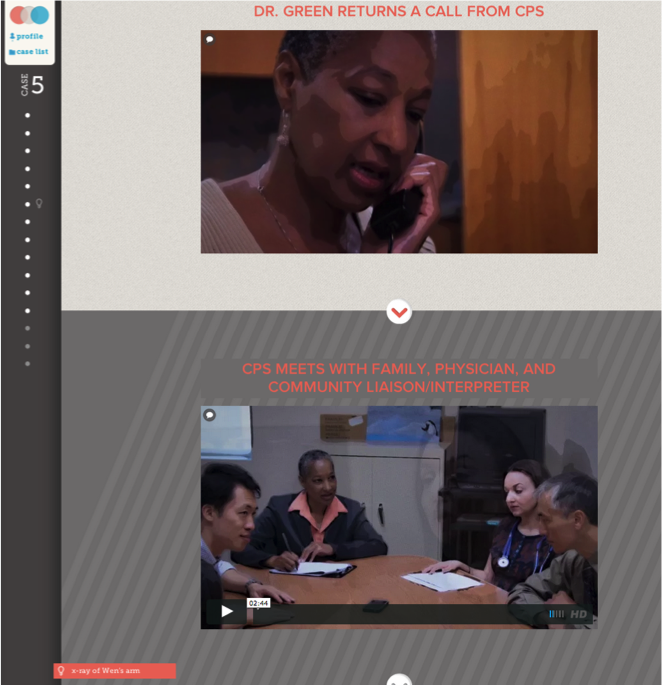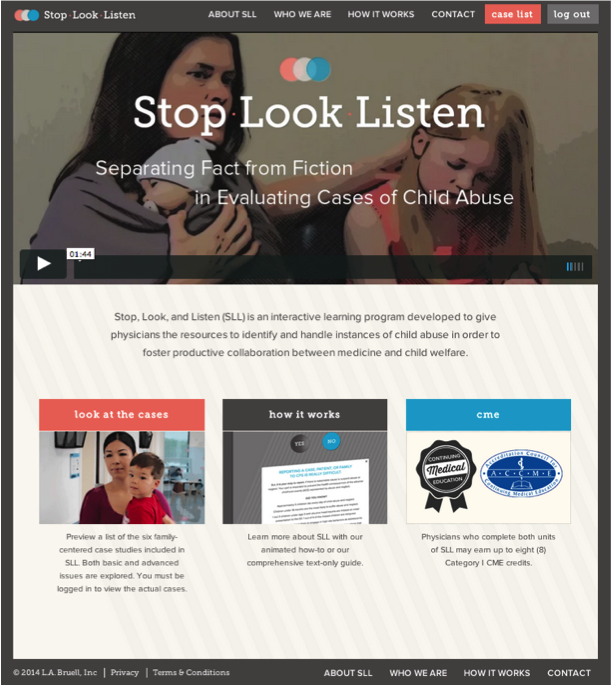


Theme
4AA eLearning courses
INSTITUTION
L.A. Bruell, Inc. - Pediatrics - New York - United States of America
Maimonides Medical Center - Pediatrics - Brooklyn - United States of America

Nearly one-third of maltreatment cases classified by physicians as "likely" or "highly" suspicious were not reported to child protective services (CARES Study, Flaherty et al., 2008). These findings point to the need for interventions targeting primary care clinicians to assist them in identifying and optimally managing suspected abuse.
Stop, Look and Listen (SLL) is an interactive teaching tool for pediatric clinicians designed to improve confidence and accuracy in identifying and reporting cases suspicious for physical abuse. It includes six scenarios which were developed by leading child abuse experts and are based on real-life cases. Each case addresses a different type of injury and takes the learner beyond reporting into the investigative process. Upon completing the program, learners will have a better understanding of the role of child protective services (CPS) and how they can collaborate effectively with these agencies to keep children safe. 8 hours of Category I CME credit are offered.


1. Creation of an interprofessional team (expert clinicians, researchers, instructional designers, graphic artists, writers) and consultation with child protective services and legal experts.
2. Identification of a core set of teaching points based on literature related to child abuse recognition and reporting, focus group findings, and case discussion meetings.
3. Content development based on actual clinical cases with details modified to ensure confidentiality and alignment with teaching points.
4. Creation of the interactive online program with multiple decision points and opportunities to compare own selections with those ofnationally recognized child abuse experts.
5. Field tested with qualitative (e.g., focus groups) and quantitative (e.g., surveys) research methods to assess the program’s strengths and weaknesses.
SLL was piloted with 37 pediatric clinicians (pediatricians, nurse practitioners, and other health professionals) from 23 states.

Additionally, a smaller sample (n=10) of pre- and post-tests were compared, with the following trends:
•Learners were more likely to identify “Consult with a child abuse specialist” and “report to CPS” as next steps in the post-test
•Learners were more likely to identify specific red flags in the post-test, including: suspicious patterns of injury, locations of injuries, and lack of a plausible history
SLL appears to be a useful educational tool that should help learners acquire new knowledge, skills, and attitudes/values.
Participants highlighted the opportunity to follow individual cases and cited viewing physician interactions with families and child protective services as a particularly helpful feature of the program.
Participants liked the interactive format and the opportunity to compare their responses to those of experts. More than half plan to make changes in their practice as a result of completing SLL, and almost all participants would recommend SLL to a colleague.
Pre- and post-test comparisons demonstrated further impact of the training.
SLL is a novel intervention to strengthen clinician confidence in recognizing and reporting physical child abuse and foster effective collaboration with other healthcare providers and child welfare professionals.
This project was supported by the Eunice Kennedy Shriver National Institute of Child Health and Human Development of the National Institutes of Health under Award Number R44HD065495-02A1. The content is solely the responsibility of the authors and does not necessarily represent the official views of the National Institutes of Health.
 Send Email
Send Email